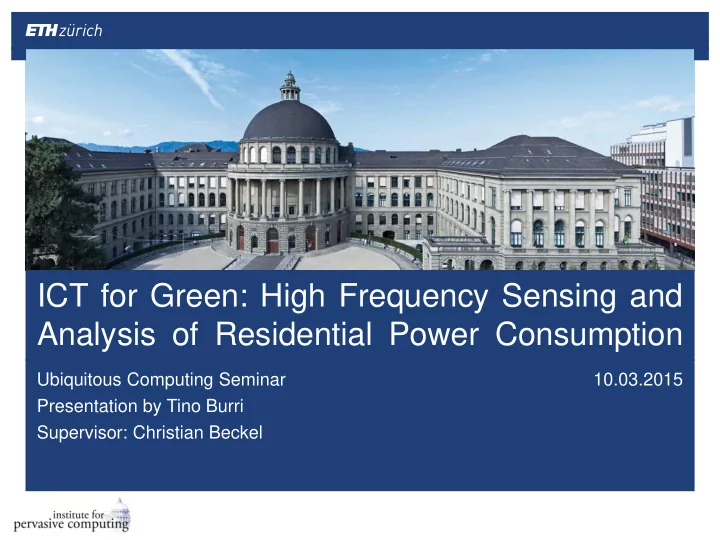

ICT for Green: High Frequency Sensing and Analysis of Residential Power Consumption Ubiquitous Computing Seminar 10.03.2015 Presentation by Tino Burri Supervisor: Christian Beckel
Importance of context information in households Reduce the power consumption Residential sector accounts for 30% of electricity Sensing & analysis of residential power consumption Collecting data Location & activity of people Home automation | 2
| 3
Load Monitoring Intrusive Load Monitoring ILM Distributed sensors Very costly Privacy issues Non-Intrusive Load Monitoring NILM Single point sensing | 4
Agenda Motivation NILM Approaches NILM by Hart [1] Patel et al. [2] ElectriSense [3] Summary & Outlook | 5
Pioneer Work: NILM by Hart (1992) Goal: Identify appliances by inspecting the overall load profile 1. Identify changes in power draw level Low frequency sampling (e.g. 1Hz) | 6
Pioneer Work: NILM by Hart (1992) 1. Identify changes in power draw level 2. Locate these changes in signature space 3. Combine ON/OFF Events | 7
NILM by Hart (1992) – Analysis Advantages + Easy to detect and track some On-Off appliances Drawbacks - Can not separate: Similar appliances Synchronous appliances Variable-load appliances | 8
High Frequency Sensing 1992 2003 2007 2010 Real/Reactive Power Harmonics Electrical Noise Gupta et al. : Hart Patel et al. ElectriSense 1 2 3 | 9
Electrical Noise Electrical noise on power line Transient noise (Patel et al. ) Continuous noise (ElectriSense) Created by fast switching of high currents High in energy Devices have unique noise signatures Stable over time | 10
Noise Sources Resistive loads No noise in operation R Transient noise in mechanical switch Inductive loads R L M Breaking/connecting of motor brushes Loads with solid state switching R L M Synchronous to internal oscillator | 11
Patel et al. (2007) – Sensing Infrastructure 60Hz AC power signal 10-bit resolution Bandpass Least significant bit represents 4mV 100Msamples/sec | 12
Patel et al. (2007) – Hardware 120VAC Notch Bandpass 60 Hz 60Hz 100Hz – 100kHz Notch Bandpass 60Hz 50kHz – 100MHz | 13
Patel et al. (2007) – Software Sliding window acquires 1us sample Sampling Store 2048 frequency components in vector 0 || V ti – V ti-1 || 2 ≥ threshold FFT . Detect ‘start’ and ‘end’ of pulse . . Average over n vectors 50k Store feature vector Store Hz Data Stream Support Vector Machine SVM N-dimensional hyperplane Machine Learning Labeled training data Separates data in classes | 14
When can an event be recognized? Strong and reproducible signatures Loads drawing less than 30mW are undetectable Solution: more than 10 bits resolution 0.5s delay between subsequent toggles Due to sampling & processing latency | 15
Type of events recognized by Patel et al. | 16
Patel et al. (2007) – Evaluation Training Phase Deployment in six homes Home 1 with a six-week period Homes 2-6 in one-week study Manually label each on-to-off event Results Overall accuracy of 88% | 17
Patel et al. (2007) – Analysis Advantages + High accuracy + Stable over time Drawbacks - Large training set Mislabeling problem Not adoptable for other homes - Mobile or portable devices | 18
EMI & SMPS SMPS switch mode power supplies Creates continuous EMI EMI electromagnetic interference Stable and unique for each device EMI signatures independent of the electrical wiring ElectriSense analyzes EMI | 19
ElectriSense – Hardware Motor voltage noise Continuous breaking/connecting of motor brushes 120V AC 60Hz Synchronous to AC frequency and its harmonics SMPS voltage noise Synchronous to internal oscillator (e.g. 10kHz) Filter out AC frequency (60Hz) Power Line Interface Bandpass 36.7kHz to 30MHz Data Analog-Digital-Converter Acquistion Digitized signal streamed to software Software | 20
ElectriSense – Software Buffers incoming signal as 2048-point vector Hardware FFT to obtain frequency domain signal Average with sliding window Real Time FFT Too small: false positive Too large: distance between events Baseline Differentiate with baseline vector Difference Difference vector ≥ threshold (8dB) Feature Extraction Store amplitude, mean, variance | 21
ElectriSense – Software (2) Hardware Real Time FFT Baseline Difference Feature Extraction | 22
ElectriSense – Evaluation Training Phase Actuate each appliance on/off Isolate signature Label and store signatures in XML database Goal: reuse database Results 2576 electrical events 91.75% accuracy | 23
ElectriSense – Analysis Advantages + Detect overlapping events + Distinguish two devices of same model + Independent of plug-in location + EMI signal is independent of the home Drawbacks - Expensive training phase - Resistive loads - Load and state of appliance | 24
NILM Summary & Outlook Low High Frequency Frequency Changes of Chagnes of Harmonics & real & reactive beyond FFT real power FFT power Hart [1] Patel et al. [1] Gupta et al. : ElectriSense [2] Combine all approaches Extract temporal features Build a Finite State Machine Crowdsourcing | 25
References (1) G. W. Hart, Original NILM by MIT Nonintrusive Appliance Load Monitoring Proceedings of IEEE 1992 (2) S. N. Patel, School of Interactive Computing, Georgia Institute of Technology At the Flick of a Switch: Detecting and Classifying Unique Electrical Events on the Residential Power Line UbiComp 2007 (3) S. Gupta, Electrical Engineering UbiComp Lab, University of Washington ElectriSense: Single-Point Sensing Using EMI for Electrical Event Detection and Classification in the Home UbiComp 2010 (4) M. Zeifman, Center for Sustainable Energy Systems, Cambridge Nonintrusive Appliance Load Monitoring: Review and Outlook IEEE Transactions on Consumer Electronics 2011 (5) J. Liang, CLP Research Institute, Hongkong Load Signature Study—Part I: Basic Concept, Structure, and Methodology IEEE Transactions on Power Delivery 2010 | 26
Recommend
More recommend